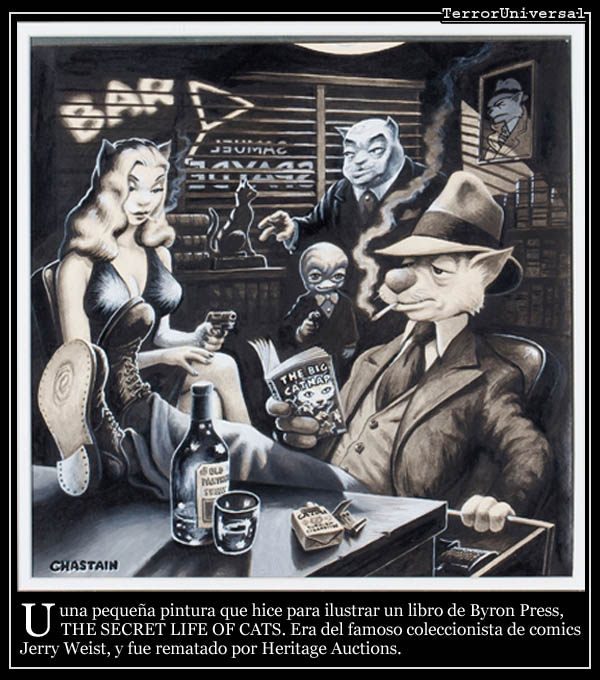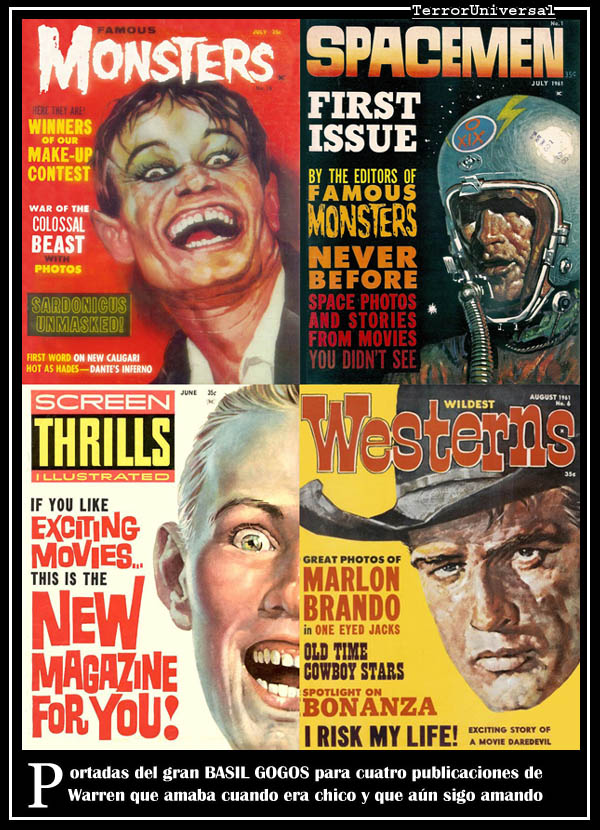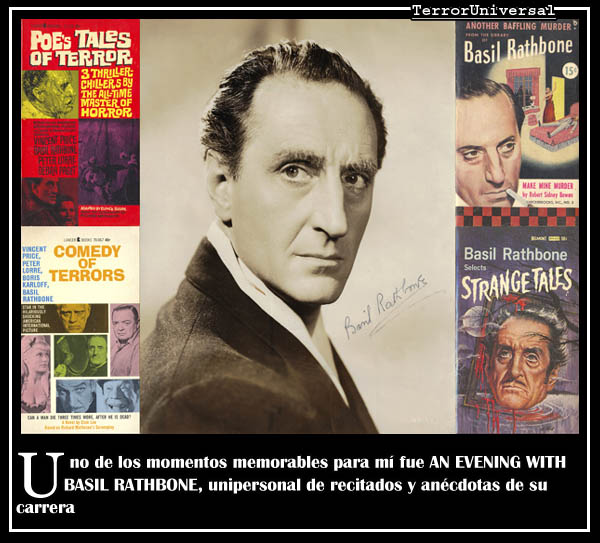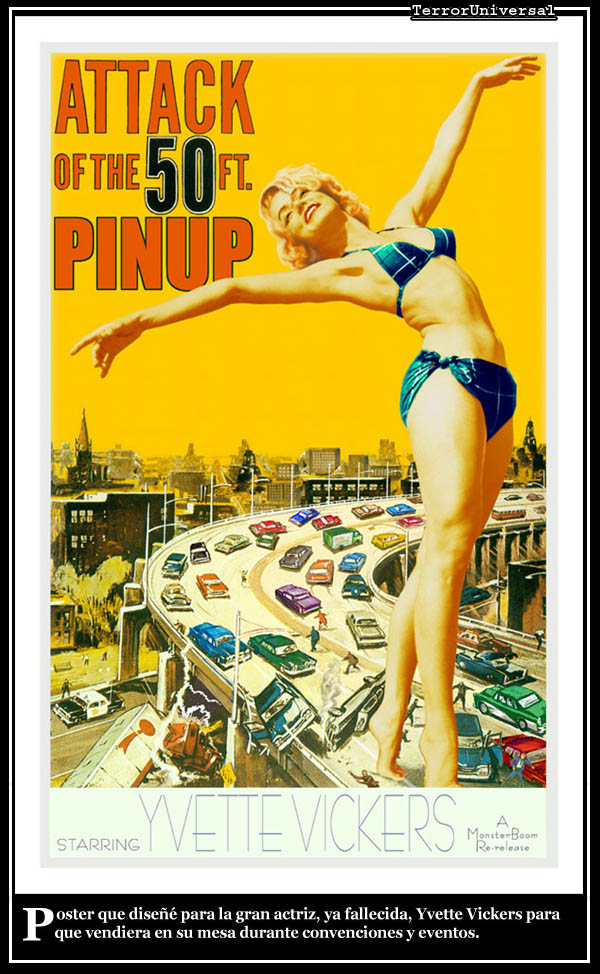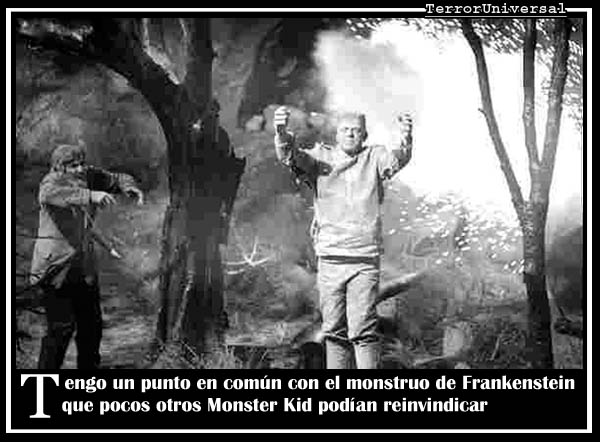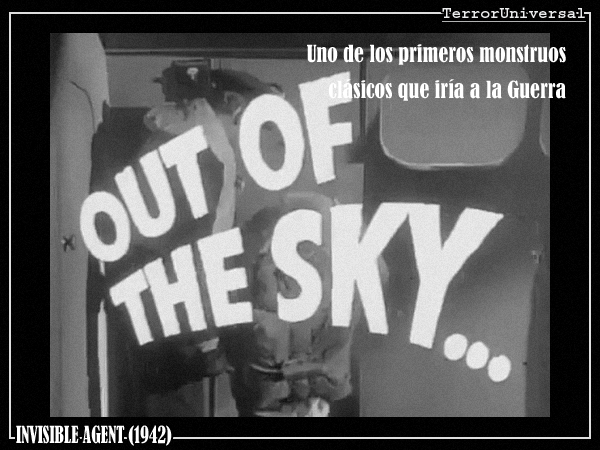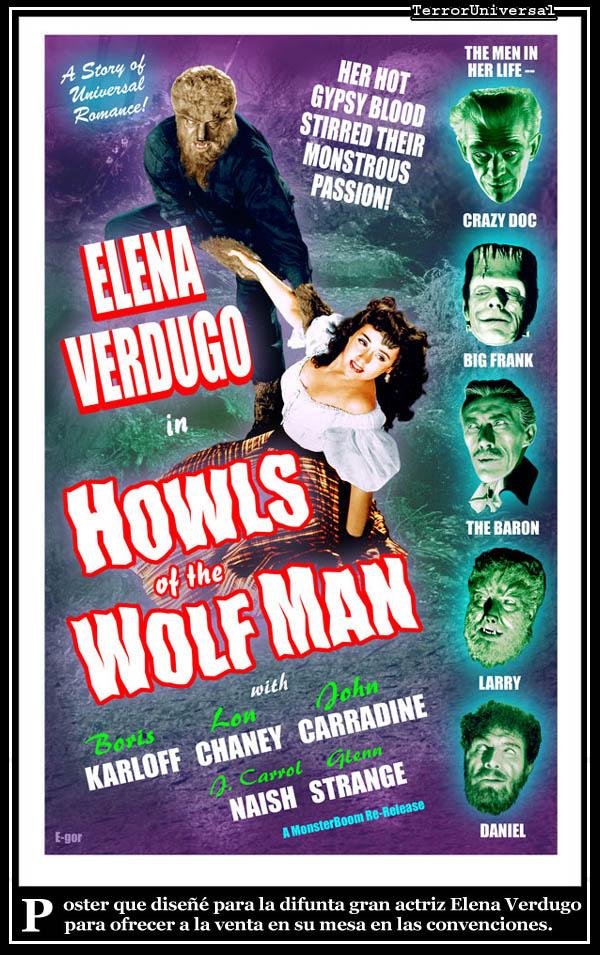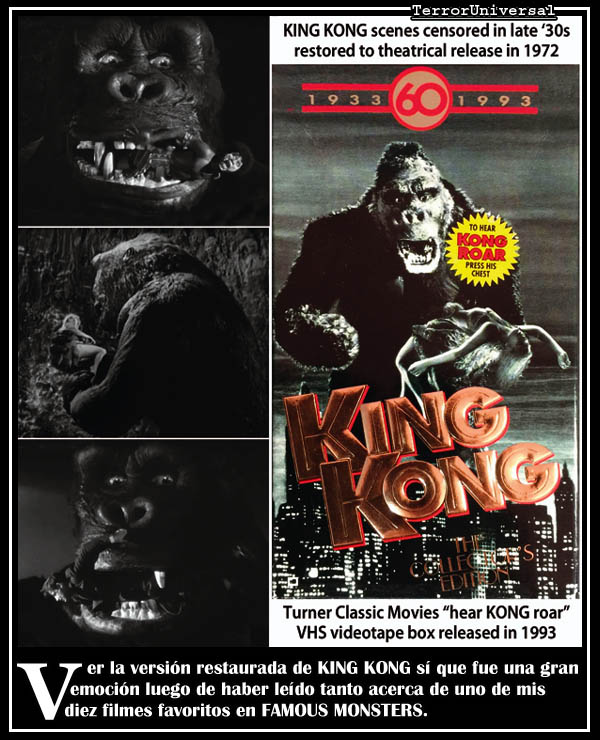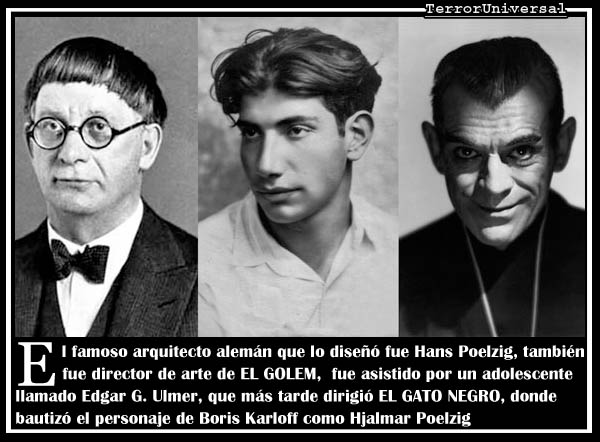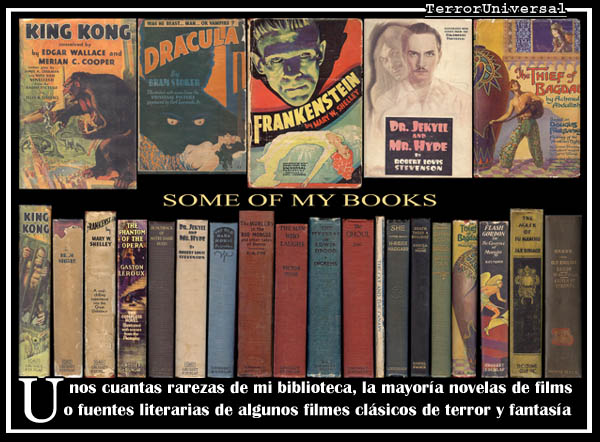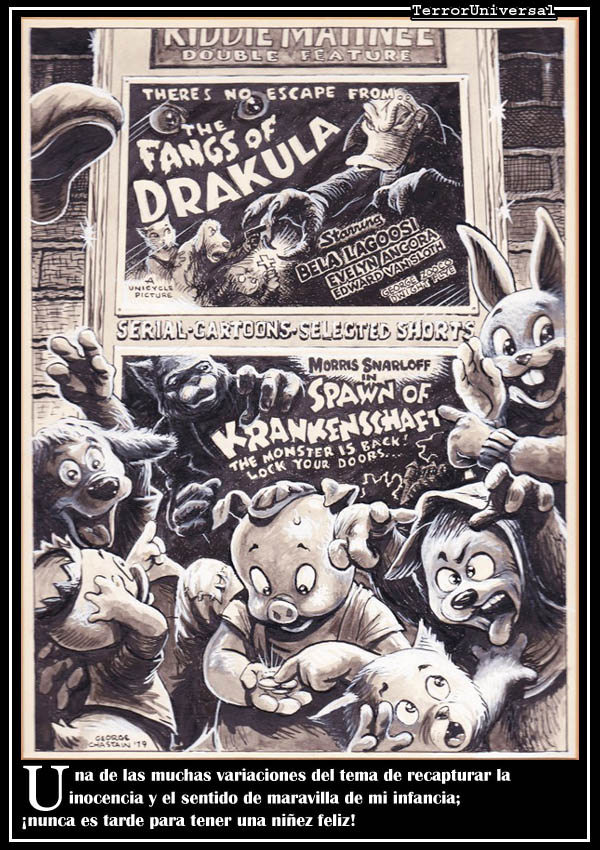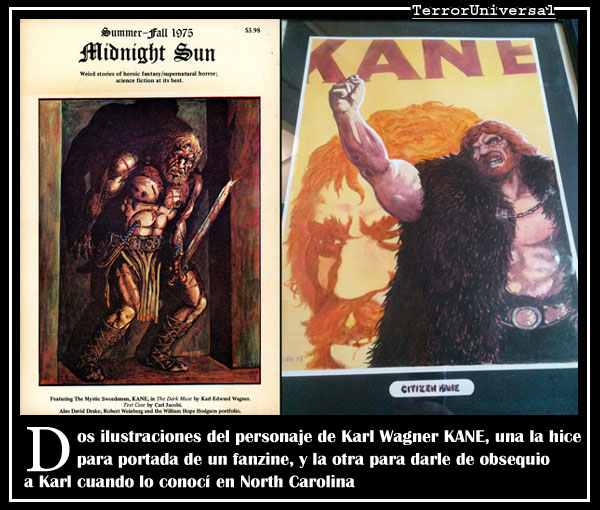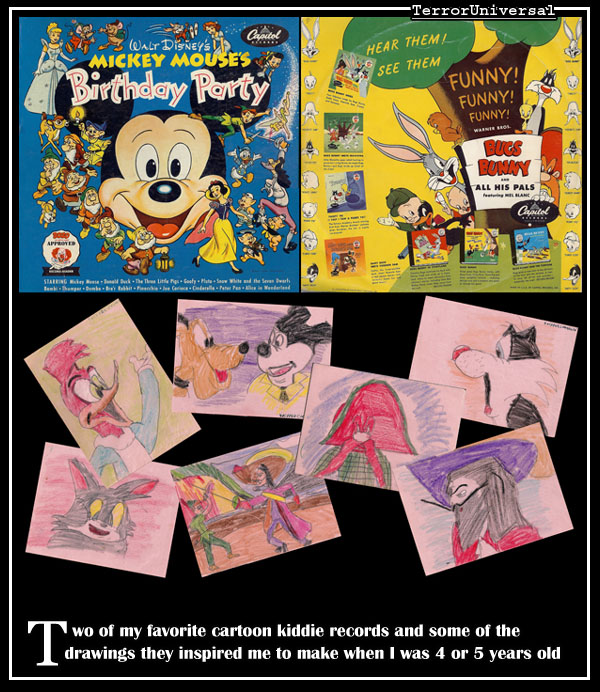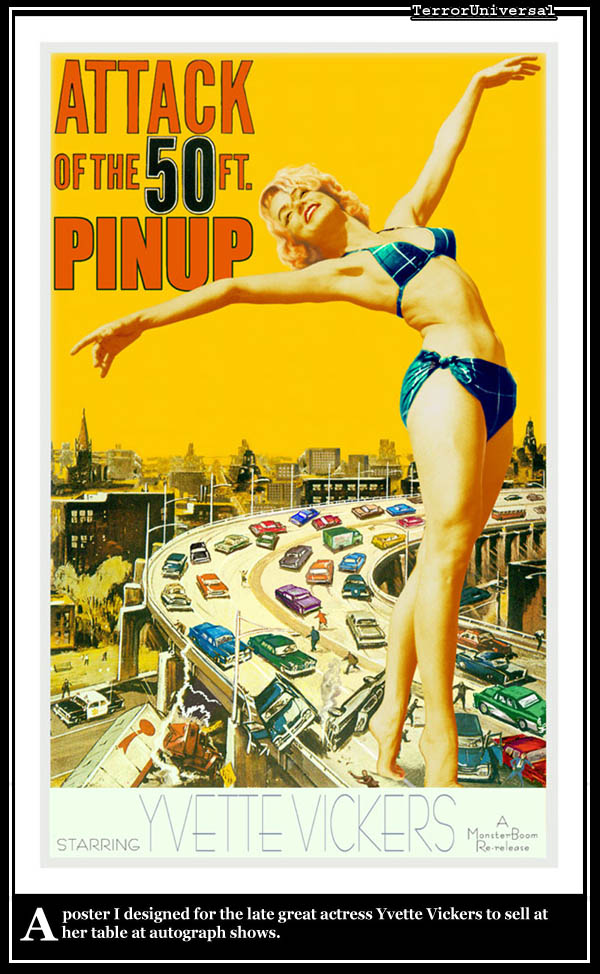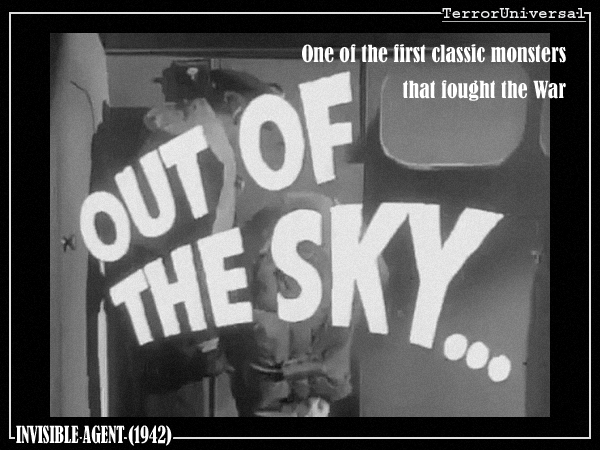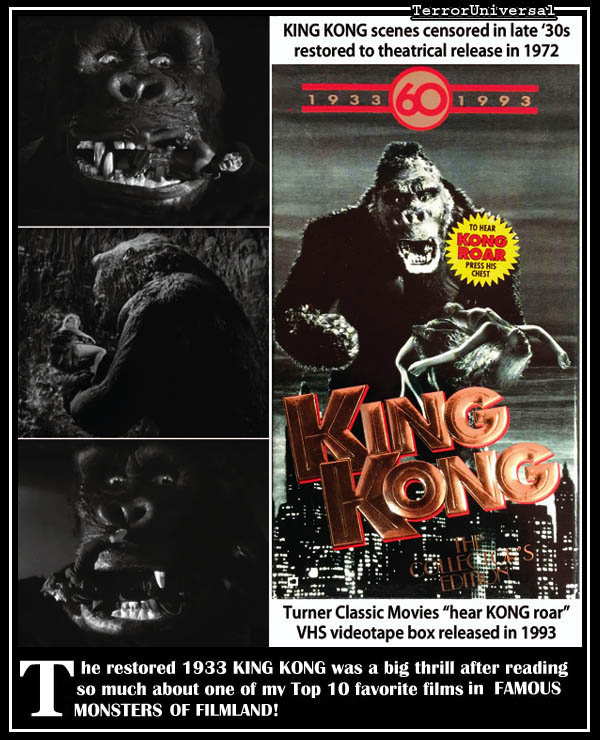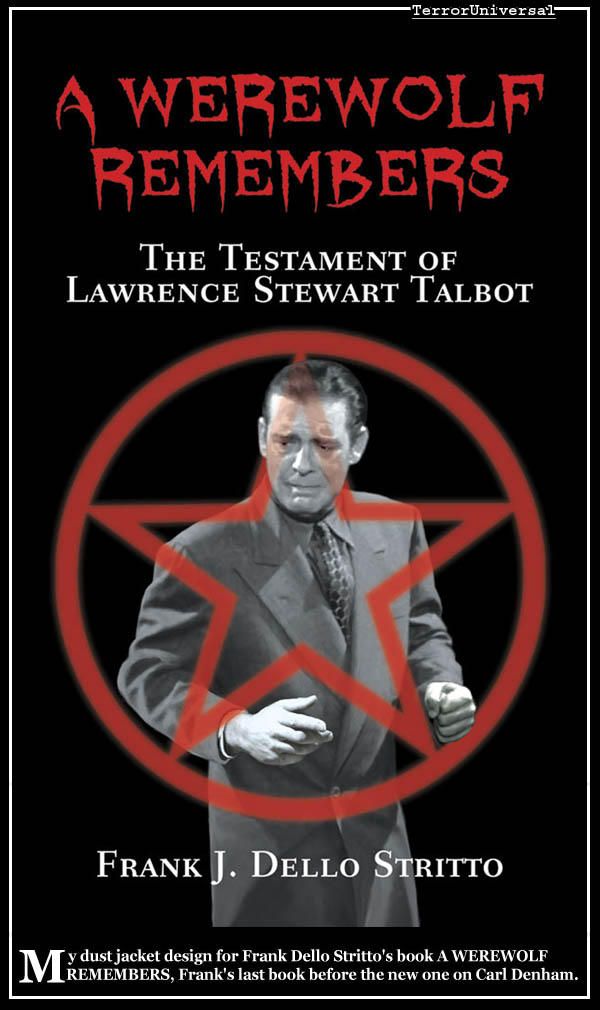 |
 |
|||
|
|
||||
George Chastain
El chico de los posters Mi fascinación con el diseño de posters comenzó cuando era un niñito (si definimos "poster" como cualquier clase de diseño compuesto por letras capitales y gráficos, como la mayoría de los avisos publicitarios). Antes de aprender a leer me entusiasmaba mucho con los diseños de las cubiertas de discos para chicos de 45 RPM que mis padres me regalaban, ya que tenían a muchos de mis personajes favoritos de Disney y Warner Bros., maravillosamente ilustrados y con las voces de Mel Blanc y Clarence "Ducky" Nash. Escuchaba esos discos una y otra vez y trataba de copiar los dibujos con mis crayones. Cuando tenía cinco años, en 1954, mi madre recolectó mis garabatos y los envió a los estudios Disney para que evalúen mi talento. Lógicamente, el empleado de la compañía le respondió que no era posible determinar si tenía auténtico talento pero como estímulo para seguir esa vocación me mandaron una fotografía autografiada de 8x10 de Walt Disney junto a la respuesta en papel con membrete de Disney.
Cuando aprendí a leer, un nuevo y mágico mundo del diseño se abrió para mí en cualquier dirección que miraba, viendo no meramente formas abstractas sino también su significado, tanto en publicidades de TV, portadas de libros, hasta en las etiquetas de alimentos en las tiendas, así como posters de cualquier clase, grandes y pequeños. El autocine Islander, en Key West (donde vi por vez primera THE CREATURE FROM THE BLACK LAGOON, SAMSON AND DELILAH y muchos otros films), tenía una alta valla de madera permanentemente cubierta con grandes, coloridos posters de los estrenos del momento y también de los próximos. Me fascinaban los posters nuevos que me quedaba viendo cada vez que pasábamos por ahí en coche o cuando hacíamos la cola para comprar nuestras entradas. Pero a la salida del espectáculo, había otro vallado con otros posters que me entusiasmaban por igual.
Tenía nueve o diez años cuando comencé a coleccionar libros de bolsillo (western, policiales, colecciones de horror, novelizaciones de películas), comics y revistas que conseguía en kioskos de diarios, farmacias, tiendas de dulces, mercados de pulgas o doquiera donde pudiera encontrarlas. Las sórdidas ilustraciones de portada eran gran parte de la atracción (siempre he juzgado a los libros por sus tapas). En aquella época y durante muchos años, no existían libros acerca de posters de películas o enfocados al diseño de los posters (hoy en día, en cambio, hay demasiados como para estar al día con todos). Pero de vez en cuando las revistas de Warren (FAMOUS MONSTERS, SCREEN THRILLS ILLUSTRATED, SPACEMEN y WILDEST WESTERNS) traían reproducciones de antiguos posters de películas a modo de ilustraciones de sus artículos y, con frecuencia, era lo que más me excitaba de aquellas revistas, a excepción de las ilustraciones a todo color de las portadas, con dinámicos rótulos y primeros planos de rostros increíbles... la mayoría de las cuales eran obra del finado BASIL GOGOS, por lejos lo que otorgaba brillantez a esas publicaciones por encima de cualquiera de la competencia.
Monster on the Campus Años después, en la secundaria, me especialicé en Artes y el primer trabajo práctico que hice fue una pintura a tempera de Bela Lugosi como Drácula, del tamaño de un antiguo poster de "one-sheet" (69 x 104 cm). Me inspiré para mi retrato de Lugosi en los diez fotogramas que había ordenada a través del Movie Star News, y le agregué el rótulo "Drácula" como título en la parte superior. El profesor no supo bien como juzgar ese trabajo no abstracto sobre un ícono de cultura popular, pero me dijo: "tiene una hermosa mano", y de hecho, traté de reproducir lo más fielmente que pude el hipnótico gesto de su mano en la foto. Desearía haber tomado una fotografía de aquel poster antes de regalárselo a la primera chica del curso de arte que me manifestó su agrado por la pintura... extraños y nuevos intereses nacían en mi imaginación.
Debo admitir que, a fines de los años '60, mi fascinación con el horror clásico pasó a segundo plano en las normales preocupaciones de la juventud de mi generación... y así se mantuvo durante varios años más, entre Sexo, Drogas y Rock & Roll... pero no fue del todo olvidada. Uno de los momentos memorables para mí fue AN EVENING WITH BASIL RATHBONE, unipersonal de recitados y anécdotas de su carrera, que fue el primer evento que presentó en la Universidad en 1965. Era el historietista del staff del periódico escolar y creo que nunca antes había entrevistado a nadie en mi vida (y mucho menos, a alguien que me impresionaba tanto), así que rogué por la chance de entrevistar a Mr. Rathbone y lo logré. Estuve bastante torpón entrevistándolo (y el actor, agotado de un largo viaje aéreo, estaba con poco ánimo de ser entrevistado para un periódico local) pero logré caerle bien y me firmó una fotografía de 8x10 (que también había ordenado a Movie Star News) junto con el ejemplar de la biblioteca universitaria de su autobiografía In and Out of Character, que leí para preparar la entrevista y que obedientemente devolví a la biblioteca. Hoy en día, alguien menos apreciativo del gran actor lo habría sustraído de la sala de libros raros. Pero conocer a Basil Rathbone y ver su maravilloso unipersonal desde la primera fila esa noche fue para mí toda una experiencia inspiradora.
Otro monstruoso hito de mi época de secundaria: conversé con el jefe del departamento de Artes para que me permita invertir $50 del presupuesto para alquilar una copia de THE CABINET OF DR. CALIGARI para proyectarla en el campus, lo que atrajo a un pequeño pero fino grupo de estudiantes. Nunca antes había visto esa película, solamente fragmentos en un gran episodio de la serie de TV HOLLYWOOD AND THE STARS titulado MONSTERS WE'VE KNOWN AND LOVED, presentado por Joseph Cotten, junto a clips de THE GOLEM, NOSFERATU, el FANTASMA y el JOROBADO de Lon Chaney, RETURN OF THE VAMPIRE de Lugosi y muchos más. Fue mi primer atisbo de muchos de los grandes clásicos primitivos del género y no llegué a ver las películas completas hasta muchos años después., Me impresionó tanto ese episodio que escribí una columna y la leí en la clase de Inglés.
At war with the Army En la universidad tuve instrucción militar obligatoria para primero y segundo año y debido a que mis calificaciones eran muy buenas, me ofrecieron escolaridad militar durante otros dos años, lo que abonaría mi escolaridad y otras expensas durante mis dos últimos años de eduacción pero también me comprometió a cuatro años de servicio luego de la graduación como oficial de las Fuerzas Armadas. A fin de año, durante un ejercicio militar en el bosque, se desató una violenta tormenta eléctrica. Los oficiales al mando debieron haber suspendido las maniobras y dar la orden de conducirnos a un refugio. Busqué cobijo bajo un árbol, en medio del bosque. Tenía puesto el uniforme de fajina, botas de combate y casco de acero, teniendo en mano mi rifle M-1, quedé empapado por el aguacero, lo que probablemente me salvó la vida al caer un rayo justo en ese árbol y la electricidad pasar alrededor de mi cuerpo mojado en vez de a través de él. No recuerdo nada de ese episodio pero me contaron que salté por los aires, mis botas se quemaron y que fui resucitado por un cadete del último año que me hizo volver a respirar y fui cargado en un jeep y llevado a toda velocidad a un hospital a varias millas de allí. Me desperté al otro día en terapia intensiva, atado a una cama de hospital, en un grito de dolor hasta que me volví a desvanecer. Mi tímpano izquierdo se había perforado y tenía quemaduras en la frente y pecho, de las partes metálicas de mi rifle, pero no otras lesiones visibles. Mis padres no sabían si quedaría en estado vegetativo hasta que me desperté; mi madre me dijo que mi personalidad cambió mucho luego de ese accidente, me hice mucho más temperamental e irritable de lo que solía ser. Traigo a colación esta experiencia personal, aparentemente no vinculada con mi amor por el cine de horror o la ilustración como nota acerca de un punto en común con el monstruo de Frankenstein que pocos otros Monster Kid podían reinvindicar. Pero eso no implica que esté de acuerdo con Ygor acerca de que "el relámpago... ¡es bueno para tí!"
Sobreviví a ese accidente (agitado pero no revuelto) y luego de terminar la secundaria y el entrenamiento militar me nombraron 2º teniente de artillería del Ejército (típica inteligencia militar: "art", "artillería", o sea básicamente la misma cosa). Hice el entrenamiento avanzado de artillería en Oklahoma, pero mi experiencia con el relámpago me dio gran empatía con las víctimas del blitzkrieg, lo que me infundió grandes dudas acerca del objeto de mi entrenamiento así que solicité ser transferido al Medical Service Corps, para el que al final no pude aprobar. En tanto, la mitad de mis compañeros de clase eran llevados directamente a Vietnam y el grupo donde yo me contaba, marchó a Alemania, en espera de órdenes que nos llevaría rumbo a Vietnam al cabo de un año. Por Gracia de Ramboona nunca fui asignado a tareas de combate, así que pasé mi servicio militar en tres diferentes cuarteles en Alemania, bebiendo cerveza, aprendiendo a fumar y gozando de los paisajes y sonidos de Alemania, incluyendo todo tipo de grandes conciertos. También me enamoré por primera vez con una bonita norteamericana que conocí ahí; Jeanne estaba casada con otro oficial y era infeliz, pero se divorció y se marchó junto a sus dos pequeños hijos a los Estados Unidos un año antes de que me dieran de baja del servicio. Nos mantuvimos en contacto a través de cartas y postales.
Pocos meses antes de que me dieran la baja, en 1972, tuve otro encontronazo con la muerte, en Frankfurt, cuando pasé junto a una bomba puesta por la célebre banda de terroristas Baader-Meinhof en la entrada del edificio I.G. Farben donde estaba trabajando, solo unos minutos antes de su detonación. Otra bomba que plantaron dentro del edificio mató al superior para el que trabajaba, el teniente coronel Paul Bloomquist. Había sido piloto de helicóptero especializado en evacuaciones y fue condecorado en la guerra de Vietnam (en 2015 fue incluído, en carácter póstumo, en el Salón de la Fama de la Aviación Militar). En varios vuelos de rescate se había puesto en grave peligro y había sido herido en tres ocasiones, pero salvó la vida de cientos de soldados heridos (de ambos bandos) antes de ser asignado al cargo de escritorio que irónicamente lo terminó matando. Fue un gran hombre y uno de los mejores amigos que jamás tuve. Unos meses más tarde, la Guerra de Vietnam llegaba a su fin, las fuerzas norteamericanas se iban reduciendo y yo retomé mi cargo de primer teniente en vez de ser promovido a capitán, antes de cumplir el plazo de cuatro años de mi servicio.
Recuerdos monstruosos de Alemania Vi la versión restaurada de KING KONG (con muchas escenas que habían sido quitadas por los censores de la década del '30) que se proyectó en pantalla grande el cine de un cuartel militar. Esa sí que fue una gran emoción luego de haber leído tanto acerca de uno de mis diez filmes favoritos en FAMOUS MONSTERS.
La segunda ciudad a la que me asignaron en Alemania, fue Darmstadt, donde la torre en ruinas del auténtico castillo de Frankenstein se eleva en una cima de una colina por encima de la ciudad antigua. El castillo fue construido en el siglo XIII y algunos suponen que fue la inspiración de la novela de Mary Shelley ya que en uno de sus viajes, ella anduvo en las cercanías. El sitio ha sido atracción turística por siglos y, desde luego, lo visité llevándome de su muro exterior una pequeña roca de souvenir que atesoro como una piedra preciosa.
El edificio I.G. Farben, mí última asignación de servicio en Frankfurt, era un gigantesco complejo construído a fines de los años '20 como sede corporativa del conglomerado I.G. Farben, la bioquímica y farmacéutica más grande del mundo de su época. Este formidable edificio zafó de los masivos bombardeos durante la Segunda Guerra Mundial, así que hizo las veces de "Pentágono europeo" durante el período de reconstrucción en la Posguerra. Cuando estuve ahí, décadas más tarde, era cuartel general del V Cuerpo del Ejército Norteamericano de Europa, hasta que el edificio fue devuelto al gobierno alemán en 1995.
Y he aquí la conexión monstruosa: el famoso arquitecto alemán que lo diseñó fue Hans Poelzig; en su carrera también fue director de arte y diseñador de varias películas silentes incluyendo la versión clásica de EL GOLEM (1920), codirigida y protagonizada por Paul Wegener. Asistiendo a Herr Poelzig en los sets de EL GOLEM se encontraba un talentoso adolescente llamado Edgar G. Ulmer, que más tarde se haría famoso por realizar filmes maravillosos con una pequeña ración de presupuesto, uno de los cuales sería mi película favorita de Karloff y Lugosi, THE BLACK CAT. En ese filme Ulmer rindió tributo a su antiguo mentor bautizando al satánico personaje de Boris Karloff como "Hjalmar Poelzig". Pero hay más conexiones monstruosas: uno de los productos fabricados por la compañía I.G. Farben fue el ZYKLON B, gas cianuro utilizado en los campos de concentración de los nazis.
De regreso a los Estados Unidos Luego de ser dado de baja del Ejército, estuve un año con mis padres en su remozada granja familiar en Carolina del Sur, que invertí en planificar qué haría durante el resto de mi vida. Sabía que lo mejor que podía hacer era tratar de ganarme la vida como artista comercial y que mis trabajos deberían volcarse a los temas que conocía y que me apasionaban. Por entonces comenzó un gran boom de nostalgia que se extendió por todo el país, en parte debido a la atención que acaparó el Pop Art en los años '60, la proliferación de salas de cine arte que atraían el interés en el cine antiguo, la creciente popularidad de los comics books antiguos, las convenciones de coleccionistas y la aparición de objetos de colección en general, todo de la mano de veloces cambios sociales. Además de revistas de monstruos y comics, yo mismo comencé a comprar algunos productos por correo, siempre atento en su búsqueda en mercados de pulgas, tiendas de segunda mano y ferias de antiguedades: ediciones antiguas de libros de ficción del género fantástico u horror, libros pulp y revistas, juguetes y discos de 78 RPM de auténtica música folk (blues, jazz y country antiguo), de las décadas del '20 al '40. Todos estos hobbies me permitieron conectarme con un montón de gente interesante a lo largo del tiempo.
Durante la mayor parte de mi vida me fascinaron los comic books, pero mis gustos se vuelcan menos hacia los rabiosamente populares superhéroes de Marvel y DC que a los antiguos comics de animales, adaptaciones de películas, revistas de horror de EC y comics underground. Me atrajo mucho lo que sucedía en el mundo del comic book así que me familiaricé con las guías de precios y publicaciones de coleccionistas, asistiendo a eventos y convenciones con el objeto también de llevar mis trabajos para exponer, vender o canjear. Inspirado por el éxito de mi artista favorito de todas las épocas, el creador del Pato Donald Carl Barks, que ofrecía sus pinturas de animales a los coleccionistas por precios asombrosos, mis pinturas eran siempre parodias de afiches de películas clásicas o portadas de sórdidas revistas pulp... parodias en las que siempre había animales antropomórficos, referencias a íconos de la cultura popular y juegos de palabras al estilo de Forrest Ackerman, la revista Mad, viejos dibujos animados, los cortos de los Tres Chiflados y otras figuras referenciales. En esta época, una vez, gané el primer premio de $300 en un concurso radial por el diseño de un poster utilizando el logo de la radio como título y un desfile de coloridos personajes en un estilo de comic.
Convenciones y eventos En una convención de coleccionistas llamada Durham Mini-Con, en North Carolina, descubrí una próspera comunidad de fans profundamente involucrados con la rica tradición de revistas pulp, especialmente las WEIRD TALES con los relatos de Robert E. Howard y H. P. Lovecraft. Ahí conocí a KARL EDWARD WAGNER que estaba consiguiendo interesante éxito como escritor, editor y publicista con su novela BLOODSTONE, acerca de un personaje fantástico llamado KANE, que salía con ilustraciones de portada de Frank Frazetta; y CARCOSA PRESS, una editorial especializada fundada por Karl y dos socios, que acababan de publicar dos antologías de relatos en tapa dura, reimpresiones de revistas pulp clásicas, WORSE THINGS WAITING de MANLY WADE WELLMAN. Mr. Wellman, uno de los últimos grandes autores de la Época de Oro de los Pulps, vivía en la región y Karl me llevó a conocerlo en su hogar. Algunas de las ilustraciones inspiradas en temas pulp y de horror clásico que hice para Karl salieron en sus publicaciones y un retrato que hice de su personaje caracterizado como "Citizen KANE", cuelga de las paredes de su oficina.
En 1975 asistí a la 1ra. World Fantasy Convention de Providence, Rhode Island, cuyo tema fue "El círculo de Lovecraft". Allí me reencontré con Wagner y Wellman junto a otros pares de la época, incluyendo al invitado de honor, ROBERT BLOCH, FRITZ LEIBER, FRANK BELKNAP LONG, JOSEPH PAYNE BRENNAN y H. WARNER MUNN, así como a otros famosos autores y editores, como RAMSEY CAMPBELL, L. SPRAGUE DeCAMP, T.E.D. KLEIN, LIN CARTER, héroe de la infancia FORREST J ACKERMAN (mi primer encuentro con él), el historietista GAHAN WILSON (que hizo las veces de maestro de ceremonias) y KIRBY McCAULEY (agente literario, director de la convención y cofundador del evento). Fue un fin de semana inolvidable y más adelante tendría el gran placer de poder trabajar con varias de estas personalidades.
Nota del editor: Este artículo continuará... No dejen de visitar la George Chastain Facebook Timeline para ver su portfolio de ilustraciones y composiciones sobre monstruos del cine clásico de horror.
The Poster Child My fascination with poster design began when I was a toddler (if "poster" is defined very broadly, as any sort of design composed of bold lettering and graphics, like most advertising art). Before I learned to read I was tremendously excited by the strong, colorful designs on the jackets of the 45 rpm kids records my parents bought me, featuring many of my favorite Disney and Warner Bros. cartoon characters, pictured on the jackets by wonderful drawings, and played by great voice actors like Mel Blanc and Clarence "Ducky" Nash. I listened to those records over and over and tried to copy the cartoon drawings on them with crayons. When I was 5 years old in 1954, Mom gathered a bunch of my childish doodles and sent them to Disney Studios for an evaluation of my talent! Of course the company spokesman said it wasn't possible to tell if I had real talent yet, but I was encouraged to keep working on it by the "autographed" 8x10 of Walt Disney that came back with my drawings, and the reply on Disney letterhead stationery.
When I learned to read, a whole new world of design magic opened up for me everywhere I looked, seeing not just abstract shapes but MEANING in TV ads, book covers, even the food labels in grocery stores--posters of every sort, big and small. The Islander Drive-In in Key West (where I saw THE CREATURE FROM THE BLACK LAGOON, SAMSON AND DELILAH and many other films), had a tall wooden fence surrounding the parking area, right by the entrance and exit driveways, and it was always covered with big, colorful posters for the current and coming movies. I was fascinated by the new posters I saw every time we drove by them to buy our tickets, and by the different ones on the other fence as we exited after the show.
I was about 9 or 10 when I started collecting paperback books (westerns, crime novels, horror story collections, movie tie-ins), comics & magazines in newsstands, drug stores, grocery stores, junk shops, wherever I could find them. The lurid covers were a big part of the attraction--I have ALWAYS judged books by their covers. In those days and for many years afterward, I couldn't find any books about movie posters or other sorts of poster design (these days there are too many to keep up with). But Warren magazines like FAMOUS MONSTERS, SCREEN THRILLS ILLUSTRATED, SPACEMEN and WILDEST WESTERNS occasionally used black & white reproductions of vintage movie posters to illustrate feature articles, and they were often the most exciting I saw in those magazines, except for the gorgeous full-color, posterish cover art, with dynamic lettering and exciting closeups of awesome faces--most often the work of the late great BASIL GOGOS, far beyond the graphic brilliance of any competitors back then.
Monster on the Campus Years later at college, I majored in Art and the first project I did for a freshman year art class was a big tempera painting of Bela Lugosi as Dracula, the size of a vintage US "one-sheet" movie poster. I based the design on my favorite portrait of Lugosi from the ten photos I ordered from Movie Star News, and I hand lettered "DRACULA" for the title at the top. The art instructor didn't quite know how to judge such non-abstract, pop culture subject matter, but he did tell me "That's a beautiful hand"--and indeed it was, rendered as faithfully as I could from Bela's hypnotic hand gesture in the photo. I wish I had taken a picture of that poster before I gave it to the first girl in art class who said she liked it--strange new interests were developing in my imagination.
I admit that my fascination with classic horror subjects took a back seat to the normal youthful preoccupations of my generation in the late '60s and for a number of years afterward, including Sex, Drugs & Rock & Roll--but not entirely. One of the highlights of my freshman year in college was AN EVENING WITH BASIL RATHBONE, his one-man show of dramatic recitations and stories about his career, the first event in the university's Fine Arts Series in 1965. I was the staff cartoonist on the campus paper, and even though I had never interviewed anybody in my life (much less somebody I was so completely awed by), I begged for the chance to interview Mr. Rathbone and got it. I was very awkward doing the interview (he was elderly and tired from a long plane trip and a bit dismissive after being interviewed at great length for a city newspaper) but I managed to stumble through it, and he signed a handsome 8x10 photo for me (also ordered from MOVIE STAR NEWS), along with the university library's copy of his autobiography IN AND OUT OF CHARACTER, which I had read to prepare for the interview, and which I dutifully returned to the library. Somebody far less appreciative of the great actor has probably stolen it from the rare books room by now. But meeting him and seeing his marvelous show from the front row that night was an inspiring experience at that time in my life.
Another monstrous highlight of my college career: I talked the head of the Art Department into letting me spend $50 from the budget to book THE CABINET OF DR. CALIGARI for a campus showing, which attracted a small but discriminating audience of students. I had never seen the film before, but I had seen clips from it in a great episode of the TV series HOLLYWOOD AND THE STARS called "Monsters We've Known and Loved," hosted by Joseph Cotten and featuring a tantalizing set of clips from THE GOLEM, NOSFERATU, Chaney's PHANTOM and HUNCHBACK, Lugosi's RETURN OF THE VAMPIRE, and much more. It was my first glimpse of many of the early classics of the horror genre, and I didn't see some of the complete films until many years later. I was so impressed with that awesome TV show that I wrote a report on it and read it to my high school English class.
At war with the Army My university had mandatory military training classes for freshman and sophomore men, and because my grades were good I was offered an Army scholarship for another two years of training, which payed my tuition and other expenses for my last two years of college, but also committed me to four years of service as an Army officer after graduation. At the end of my junior year, during "War Games" in the campus forest, a violent thunderstorm suddenly blew up, and the officers in charge failed to cancel the maneuvers and call us in to shelter. I was hunkered down under a tree in the forest, wearing fatigues, combat boots and a steel helmet and carrying an M-1 rifle, and I was totally drenched by the rainstorm-- which probably saved my life when the tree and I were struck by lightning, since most of the powerful charge was conducted around my wet body instead of through it. I don't remember anything about the experience but I was told that I was blown through the air, my boots were blasted off, I was resuscitated by a senior cadet to jump-start my breathing, and I was loaded into a jeep and rushed to a hospital many miles away. I woke up the next day in the intensive care ward, where I had been strapped down on a hospital bed, bright purple and screaming in pain until I passed out. My left eardrum had been blasted out, and I had burns on my forehead and chest from the metal parts of my rifle, but no other visible signs of damage. My parents didn't know if I would be brain-dead from the experience until I woke up; my Mom told me later that my personality changed a lot after the accident, and I was much more moody and irritable than I used to be. (I'm bringing up this personal stuff that seems unrelated to my artwork and love of horror films only to point out something I have in common with Frankenstein's Monster that few if any other Monster Kids in the world can claim. But I do NOT agree with Ygor that "The lightning. It is GOOD for you!"
I survived the accident (shaken but not stirred) and finished college and Army basic training, and then was commissioned as a 2nd Lieutenant in the Artillery branch of the U.S. Army (typical military intelligence: "art," "artillery," basically the same thing). I attended advanced artillery training in Oklahoma, but my lightning experience gave me so much sympathy with blitzkrieg victims that I had grave misgivings about what I was being trained to do, and I applied for a branch transfer to Medical Service Corps, which was finally disapproved about a year later. Meanwhile, half of my artillery class went directly to Vietnam, while my half went to Germany, expecting Vietnam orders within a year. By the Grace of Ramboona I was never assigned to combat duty, and I spent my entire Army hitch in three different duty stations in Germany, drinking beer, learning to smoke, and enjoying the sights and sounds of Germany, including great concerts of all sorts. I also fell in love at first sight with a beautiful American woman I met there; Jeanne was unhappily married to another officer, but she divorced him and went back to the States with her two small boys a year before I was discharged. We kept in touch through cards and letters.
A few months before I got out of the Army in 1972, I had another brush with death in Frankfurt, when I walked right by a pipe bomb planted by the notorious Baader-Meinhof gang of terrorists at the entrance to the I.G. Farben Building where I worked, just a few minutes before it exploded. Another bomb planted behind the building killed the man I worked for, Lt. Col. Paul Bloomquist. He was a highly-decorated medical evacuation helicopter pilot in the Vietnam War who was inducted posthumously into the Army Aviation Hall of Fame in 2015. He put himself in harm's way flying countless rescue missions and was wounded in action three times, but he saved the lives of hundreds of wounded soldiers (on both sides) before he got the desk job that killed him. He was a very fine man and one of the best friends I ever had. A few months later, the Vietnam War was winding down, American forces were being reduced, and I was able to resign my commission as a 1st Lieutenant instead of being promoted to Captain, more than a year short of my original 4-year service commitment.
A few monster memories from Germany I saw the restored 1933 KING KONG (with many scenes replaced that had been cut out by censors in the '30s) projected on a big screen at an Army post theater. That was a big thrill after reading so much about one of my Top 10 favorite films in FAMOUS MONSTERS!
My second duty station in Germany was in Darmstadt, where the tower and ruins of the actual CASTLE FRANKENSTEIN lie on a hilltop in the low mountain range overlooking that ancient city. The castle was constructed in the 13th Century, and some say it may have been an inspiration for Mary Shelley's novel, since she had traveled very near to it. The site has been a tourist attraction for centuries so of course I visited it, and I carried away a small stone from a rock wall on the grounds as a treasured souvenir.
The I.G. Farben Building, my last duty station in Frankfurt, was a HUGE office complex originally built in the late '20s as the corporate headquarters of the I.G. Farben conglomerate, the world's largest chemical & pharmaceutical company at the time. This gigantic building was spared from the massive bombing of Frankfurt so that it could serve as "the Pentagon of Europe" during the post-War reconstruction period. When I worked there decades later it was the headquarters for V Corps, US Army Europe, but the building was transferred back to the German government in 1995.
Here's the MONSTER connection: the famous German architect who designed the I.G. Farben building was HANS POELZIG; earlier in his career he was the art director and production designer for a number of German silent films, including the classic 1920 version of THE GOLEM starring and co-directed by Paul Wegener. Assisting Poelzig on set designs for THE GOLEM was a talented teenager named EDGAR G. ULMER, who later became famous himself for producing marvelous films on shoestring budgets, including my favorite Karloff & Lugosi film, THE BLACK CAT. In that film Ulmer paid an odd tribute to his former mentor by giving his name to Boris Karloff's satanic character, "Hjalmar POELZIG"! There is a far more monstrous connection: one of the products made by the I.G. Farben company was the ZYKLON B cyanide gas used in the Nazi death camps.
Back in the USA After I was discharged from the Army, I stayed with my parents in their renovated old family farmhouse in South Carolina for about a year, trying to figure out what to do with the rest of my life. I knew that my best bet was to try to make a living as a commercial artist, and that my personal artwork should be focused on subjects that I knew about and loved. A big Nostalgia Boom was happening all over the country, partly due to the serious attention given to Pop Art in the '60s, the proliferation of revival movie houses and renewed interest in old films, the growing popularity of vintage comic books, collectors' conventions and cool vintage collectibles in general, and other rapidly developing social changes. I was beginning to collect other things besides comic books and monsterzines too, buying some items by mail when they were in my price range, and always looking for them at flea markets, thrift stores and antique malls: old editions of classic ghost and horror fiction, vintage paperbacks and mainstream magazines, toys, and original 78 rpm records of authentic "folk music" (blues, jazz and early country) from the '20's-'40's. All of these hobbies led me to wonderful connections with many interesting people in the future.
I had been fascinated by comic books most of my life, but my taste leaned less toward the wildly popular Marvel and DC superheros than to vintage funny animals, movie tie-ins, EC horrors, and underground comix. I tuned in and turned on to what was happening in the comic book world by studying price guides and other collectors publications, and by attending nearby fan gatherings and major big city comic conventions, always bringing some of my latest artwork along to show and sell or trade. Back then, inspired by the great success of my all-time favorite comic book artist (Disney Duck creator CARL BARKS), who was selling his funny animal paintings to comic collectors for astonishing prices, my paintings were usually oddball spoofs of vintage movie posters or lurid pulp magazine covers--loving parodies full of anthropomorphic animal cartoon characters, pop culture references, very tedious hand lettering, and twisted puns in the style of Forry Ackerman, MAD magazine, old cartoons, 3 Stooges shorts and many other pop culture resources. Sometime in this period I won the first prize of $300 in a radio station contest for a poster design using the station call letters as the bold title and a parade of colorful cartoon characters in underground comix style.
Cons and Pros At a collectors convention called the DURHAM MINI-CON in North Carolina, I discovered a thriving community of fans and pros who were deeply involved with the rich tradition of pulp fiction magazines, especially in the WEIRD TALES vein of stories by Robert E. Howard and H. P. Lovecraft. I met KARL EDWARD WAGNER there when was having great early success as a writer, editor and publisher: his paperback novel BLOODSTONE, about his immortal heroic fantasy character KANE, had just come out with a cover by Frank Frazetta, and CARCOSA PRESS, a specialty publishing company started by Karl and two partners, had recently published its first hardcover collection of stories reprinted from classic pulp magazines, WORSE THINGS WAITING by MANLY WADE WELLMAN. Mr. Wellman, one of the last of the great writers from the Golden Age of the Pulps, lived in the area and Karl introduced me to him in his home. Some of the pulp- and classic horror-inspired artwork I did for Karl was published in fan publications, and one portrait I painted of Karl's character as "Citizen KANE" hung in the office where he worked.
In 1975, I attended the 1st World Fantasy Convention in Providence, Rhode Island, where the theme was "The Lovecraft Circle". I met Wagner and Wellman again there, along with many of Wellman's surviving peers from that era, including ROBERT BLOCH (guest of honor), FRITZ LEIBER, FRANK BELKNAP LONG, JOSEPH PAYNE BRENNAN and H. WARNER MUNN, as well as other famous writers and editors like RAMSEY CAMPBELL, L. SPRAGUE DeCAMP, T.E.D. KLEIN, LIN CARTER, my childhood hero FORREST J ACKERMAN (meeting him for the first time), monstrous cartoonist GAHAN WILSON (toastmaster), and KIRBY McCAULEY (literary agent, convention chairman, and co-founder of the event). It was an unforgettable weekend, and I would enjoy working with several of these famous people in the future.
Editor's Note: This article to be continued... Don't forget to visit George Chastain Facebook Timeline and see his portfolio of classic movie horror artwork.
| atrás | recomendar esta página | enviar comentarios | arriba | |
© 2025 Terror Universal |

